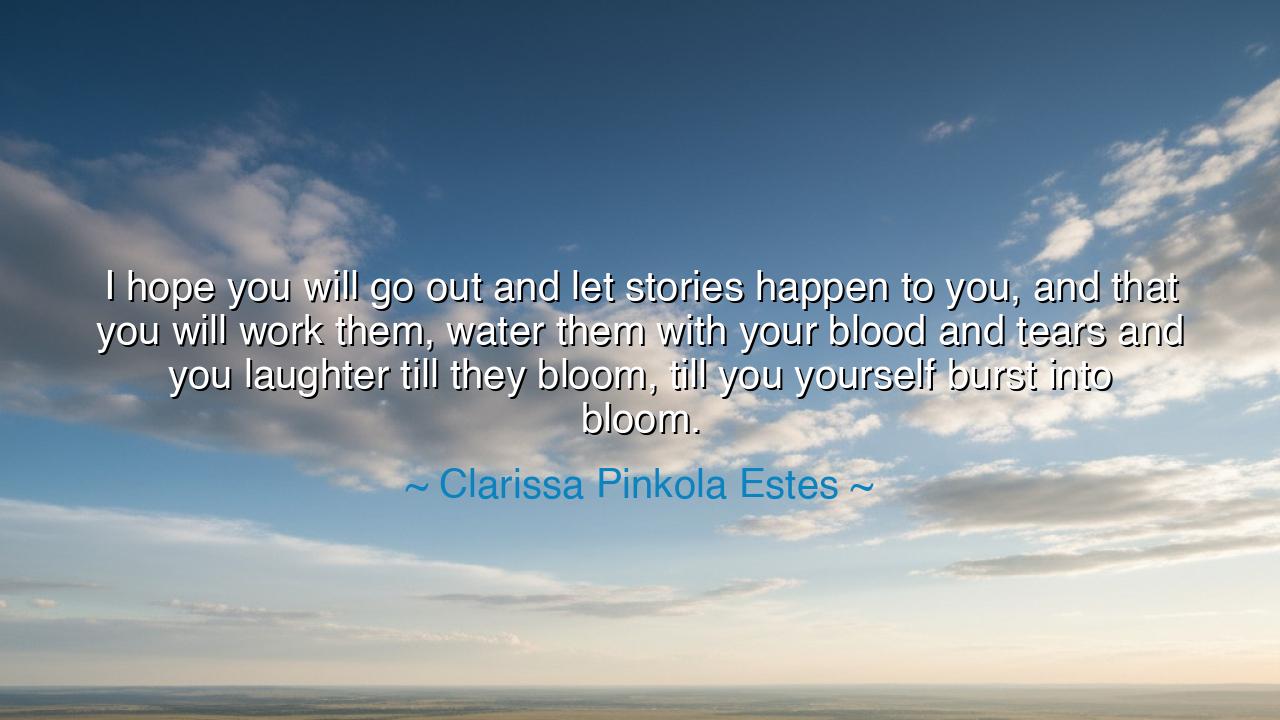
I hope you will go out and let stories happen to you, and that
I hope you will go out and let stories happen to you, and that you will work them, water them with your blood and tears and you laughter till they bloom, till you yourself burst into bloom.






Hear now, O child of the ever-turning world, the luminous words of Clarissa Pinkola Estés, poet, psychologist, and keeper of the old stories. She spoke thus: “I hope you will go out and let stories happen to you, and that you will work them, water them with your blood and tears and your laughter till they bloom, till you yourself burst into bloom.” In these words lives a sacred call — a call not merely to live, but to live deeply, to let life touch you so profoundly that you become transformed by the very experiences that shape you. For she speaks not of fiction, but of the story of the soul, the grand and mysterious narrative that every human being is born to write through the living of their days.
Clarissa Pinkola Estés, a storyteller rooted in the traditions of Jungian psychology and myth, devoted her life to awakening what she called the “wild woman” — the instinctual, creative, and spiritual force buried within every human soul. Her quote comes from her writings that blend myth and psyche, most notably Women Who Run With the Wolves. When she speaks of “letting stories happen,” she invites us to abandon the safety of passivity and to enter the mythic flow of life, to let experiences — both painful and joyful — unfold and shape us into something fuller, wiser, and more real. Stories, to Estés, are not entertainment but initiation. They are the fires through which the soul forges its light.
She reminds us that life’s stories do not simply come to us — they happen through us. To “water them with your blood, your tears, and your laughter” is to live fully, to give yourself over to existence without reserve. The blood is the sacrifice, the effort, the pain of growing. The tears are the griefs and losses that soften the heart and make it fertile. The laughter is the joy that renews and redeems. And when these elements mingle, when one has truly lived — through both suffering and celebration — one does not remain the same. The seed of experience flowers, and the soul, having tended its garden with courage, finally blooms.
Think, if you will, of the life of Frida Kahlo, the artist of Mexico whose body was broken, yet whose spirit grew vast enough to encompass the world. Through her pain — her shattered bones, her loneliness, her endless endurance — she painted her truth. Her art was her story, watered by her blood and tears, yet blooming in colors so vivid they transcend her suffering. She did not hide from her wounds; she transformed them into beauty. So too does Estés urge us: do not flee your experiences, however hard or humbling. Work them, as the sculptor works the stone, until what was once agony becomes art, and what was once hardship becomes wisdom.
This, then, is the heart of Estés’ teaching: that the purpose of life is not to escape pain, but to transform it into meaning. She speaks as the ancients did, reminding us that the soul is a living garden — and that without the rains of sorrow and the heat of passion, nothing can grow. The stories that “happen” to us are the seeds of our transformation. We may resist them, fear them, even curse them, but they are the raw material from which we are shaped into our truest selves. To deny them is to deny our own becoming.
And so, O listener, she commands us not to wait for the perfect story or the gentle one, but to step boldly into the unknown — to meet life with open hands. Go out and let stories happen to you. Seek not to control them, but to live them with depth and honesty. When joy visits, welcome it. When sorrow breaks you, let it break you open. When laughter comes, let it ring until it becomes prayer. For every experience, if embraced with awareness, becomes a teacher — and through such lessons, you will not merely survive, but bloom.
In this way, Clarissa Pinkola Estés joins the lineage of ancient storytellers and mystics — those who taught that life itself is the greatest myth, and that we are both its tellers and its told. Her words remind us that the human spirit was not made for comfort, but for growth; not for stagnation, but for transformation. And so, if you would live wisely, do not shrink from your story. Tend it. Work it. Pour your essence into it until it blossoms with the truth of who you are.
For in the end, her promise is this: when you have given yourself wholly to the stories that shape you — when your laughter and your tears have watered the roots of your being — you will awaken one morning not as the one who lives a story, but as the one who is the story, radiant and whole. Then, and only then, will you know what it means to burst into bloom.






AAdministratorAdministrator
Welcome, honored guests. Please leave a comment, we will respond soon